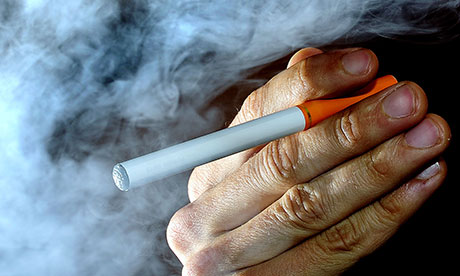
Cheryl Cole, Robert Pattinson and Kate Moss have all been seen "vaping". Puffing on e-cigarettes, which produce vapour instead of smoke has been tried by up to 35% of smokers, according to the public health charity Ash (Action on Smoking and Health). The number of UK users rose from 700,000 last year to 1.3 million this year. Smokers seem to use them on top off their normal cigarette intake, or to help them quit.
But are e–cigarettes much less damaging than the real thing? These battery-operated devices contain a cartridge filled with a liquid solution of nicotine, propylene glycol (used in special effects to create fog) and flavourings that range from traditional tobacco to candy floss. Puffing activates a heating element that vapourises the liquid in the cartridge, producing a mist that is inhaled.
Vaping has divided the medical community. Some doctors sensibly say that it is best to avoid inhaling chemicals altogether, that no long term research exists on the safety of e-cigarettes and that there is no evidence that they help people stop smoking. There are also worries that e-cigarettes will encourage non-smokers and young people to try vaping, though at least one survey suggests this isn't happening).
Others argue that they are much safer than cigarettes, therefore it is a no-brainer to encourage smokers to switch to vaping. This summer, the Medicines and Healthcare Products Regulatory Agency (MHRA) said it would regulate e-cigarettes from 2016. Meanwhile, the World Health Organisation has offered guidance suggesting they are best avoided. So, should you make the switch?
The solution
The amount of nicotine contained in e-cigarettes varies. (Smoking can make blood nicotine levels reach 15 to 20 nanograms per millilitre compared with between 3 and 5 ng/ml for vaping.) Nicotine causes a rise in blood pressure and heart rate and is highly addictive. Propylene glycol irritates the lungs when inhaled. A small study from Greece suggested that vaping made it harder to move air through the airways in the lungs. But Ash argues that what evidence there is suggests only mild side-effects and low toxicity for vaping.
A recent 12-month study took 300 Italian smokers who were not intending to quit and randomised them into three groups. They were given e-cigarettes of varying nicotine concentrations to use. After a year, 11% had given up smoking – a figure comparable to, but no better than other nicotine-replacement therapies such as patches. The number of cigarettes smoked by those who didn't give up fell by half across all groups. Smoking is so bad that it is hard to see how vaping can't be better. But it is still best to not inhale chemicals at all.

